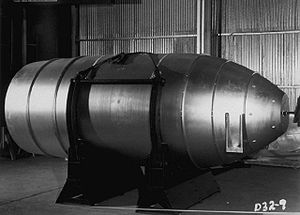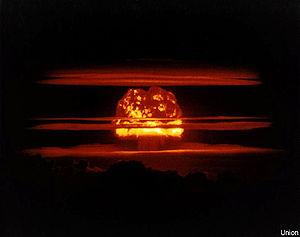
Mark 14 nuclear bomb
Encyclopedia


MK14
The Microcomputer Kit 14, or MK14 was a computer kit sold by Science of Cambridge of the United Kingdom, first introduced in 1977 for UK£39.95. The MK14 eventually sold over 50,000 units. It used a National Semiconductor SC/MP CPU , 256 bytes of random access memory which was directly expandable...
.
The Mark 14 nuclear bomb was a 1950s American thermonuclear bomb, the first solid-fuel staged
Teller-Ulam design
The Teller–Ulam design is the nuclear weapon design concept used in most of the world's nuclear weapons. It is colloquially referred to as "the secret of the hydrogen bomb" because it employs hydrogen fusion, though in most applications the bulk of its destructive energy comes from uranium fission,...
hydrogen bomb. It was an experimental design, and only five units were produced in early 1954. It was tested in April 1954 during the Castle Union
Castle Union
Castle Union was the code name given to one of the tests in the Operation Castle series of American nuclear tests. It was the first test of the TX-14 thermonuclear weapon , one of the first deployed U.S...
nuclear test and had a yield
Nuclear weapon yield
The explosive yield of a nuclear weapon is the amount of energy discharged when a nuclear weapon is detonated, expressed usually in the equivalent mass of trinitrotoluene , either in kilotons or megatons , but sometimes also in terajoules...
of 6.9 Mt
TNT equivalent
TNT equivalent is a method of quantifying the energy released in explosions. The ton of TNT is a unit of energy equal to 4.184 gigajoules, which is approximately the amount of energy released in the detonation of one ton of TNT...
. The bomb is often listed as the TX-14 (for "experimental") or EC-14 (for "Emergency Capability"). It has also been referred to as the "Alarm Clock" device though it has nothing to do with the design by the same name proposed earlier by Edward Teller
Edward Teller
Edward Teller was a Hungarian-American theoretical physicist, known colloquially as "the father of the hydrogen bomb," even though he did not care for the title. Teller made numerous contributions to nuclear and molecular physics, spectroscopy , and surface physics...
and known as the Sloika in the Soviet Union.
The fusion fuel used by the bomb was 95% enriched Lithium isotope 6 lithium deuteride, which at the time was a scarce resource and chiefly responsible for its limited deployment. The Castle Bravo
Castle Bravo
Castle Bravo was the code name given to the first U.S. test of a dry fuel thermonuclear hydrogen bomb device, detonated on March 1, 1954 at Bikini Atoll, Marshall Islands, as the first test of Operation Castle. Castle Bravo was the most powerful nuclear device ever detonated by the United States ,...
(shrimp device) showed that unenriched Lithium isotope 7 functioned as well for thermonuclear reactions as isotope 6. The Mk-14 bomb had a diameter of 61.4 inches and a length of 222 inches. They weighed between 28,950 and 31,000 lbs, and used a 64 ft parachute.
The version tested at Castle Union used a RACER IV
RACER IV
RACER IV was a component of several of the first hydrogen bombs made by the United States during the 1950s. It was the first stage for three of the devices tested in four shots of the Castle series...
primary, and had 5 Mt of its total yield due to fission, making it a very "dirty" weapon.
By 1956, the components of all of the five produced Mk-14 bombs had been recycled into Mark 17
Mark 17 nuclear bomb
The Mark 17 and Mark 24 were the first mass-produced hydrogen bombs deployed by the United States. The two differed in their "primary" stages. The MK 17/24 bombs were long, diameter. They weighed 21 tons. The Mark 17 had a yield in the range of 25 megatons TNT equivalent...
s.

